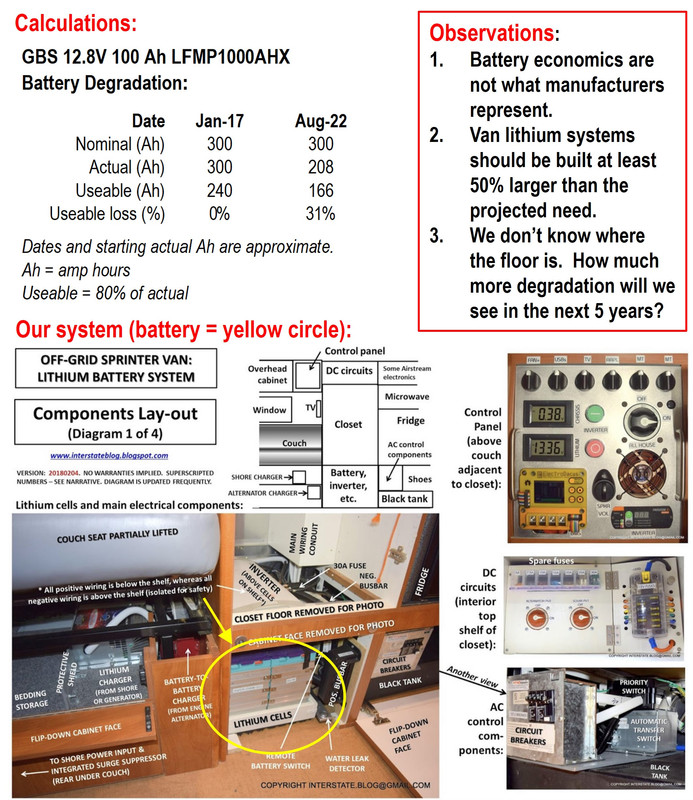This is a cross-post from a
thread I published on Air Forums because that is where my husband and I started our lithium conversations back in the day. But the considerations I describe below really apply to Class Bs generally, so Iím placing this content here as well, and I am curious as to what other early adopters are now discovering about their own lithium systems.
***
TL;DR = three takeaways in the image below.
Unpacking = as follows:
Iím reporting back on longitudinal performance of our lithium battery system which pre-dates most of those in operation today and thus provides a valuable real-world data point. My husband is an engineer and we were early adopters, with him designing and installing our customized system to dovetail into the available space in our 2007 Airstream Interstate van.
Back when we did this work, there were no off-the-shelf options for consumers who wanted lithium-based house battery systems. There was the well-known indie installer nicknamed Lewster and precious few others who were doing installs commercially, but most systems were built by skilled DIYers like ourselves.
At that time, the concerns of the installer community were limited to the following:
(1) How to design the system to prevent it from inadvertently charging in below-freezing temperatures, which would destroy the lithium cells.
(2) How to secure the lithium cells in the van so that they would not get damaged and start a fire in a crash.
(3) How many cycles the manufacturers were representing in the lifespan of lithium cells (acceptable losses were anticipated after a few thousand charging cycles over about a decade of use).
And guess what?? As is often the case with bleeding-edge technology, the factor that NOBODY was talking about turns out to be the thing that is actually driving this bus: time-dependent degradation that may or may not be exacerbated by climatic factors (especially heat) and which has little or nothing to do with ďcyclesĒ.
And why might that oversight have occurred? Because back when they started selling us this stuff, I suspect that manufacturers did not have 5+ year performance data. These battery products were all new. The best they could do was report cycle data. They can bench-test cycles, but in the rush to market, they canít bench-test Father Time.
The challenges with my take-aways in the image below are obvious. Vanners typically donít have the space to build their systems 50% larger than their calculated needs - we certainly donít, with our battery cells tucked under our closet floor.
Plus at this point, we donít even know how bad time-related degradation is going to get. Will it decelerate? Is it better to build systems larger at the outset, or should we simply plan to replace a smaller system in-kind around the 5-year mark because performance is just going to keep getting worse?
We suspect that a heat impact may be amplifying our time-related losses. Last night, my husband was web-chatting with
Dacian Todea who designed and produced the Electrodacus BMS that we have been using since the outset of our lithium battery adventures. Dacian installed the same brand of ďpremiumĒ batteries that we did, and he reported a 22% useable capacity loss in approximately the same period of time, vs. our 31%. But we live in one of the hottest metro areas of the country whereas he lives in Saskatchewan Canada, so we may be seeing an acceleration effect.
Many questions, few answers at this point. As for the unscheduled financial OUCH, I look at the bright side, which some of you techies might have snapped to before even getting to this paragraph:
The jury is still out on how badly time-dependent degradation affects lithium iron phosphate batteries in automotive applications generally. We donít yet know what the longitudinal performance profiles will look like for the newest generations of hybrid passenger cars and EVs (e.g., Tesla did not begin mainstream production until 2018 - prior to that, it was a niche product with a very long wait list). My gasoline-only Toyota Sienna is now 12 years old with 135,000 miles on it, and Iíve been weighing when to buy a new one, having almost pulled the trigger a couple of times recently. But all Siennas are hybrids at this point, and there is NO WAY I am going to purchase ANY car with LiFePO4 components until I have a much better understanding of this emerging situation. So we may be sucking unexpected financial wind on our Class B lithium battery, but I feel like I just dodged a major bullet by having this come to my awareness now, before I spent far more money on it in the form of a new daily driver. Whew.
I encourage people to post additional examples of this phenomenon in this thread as we go forward.
As an aside, forum long-timers may have wondered why after 9 years of Class B ownership with a premium lithium system I was
suddenly spending so much time and energy rehabbing our propane generator. Now you know the Paul Harvey rest of the story - because we knew that our lithium battery was failing and could no longer keep up with our energy needs. We just didnít have time to perform a capacity test and quantify that degradation until yesterday.
